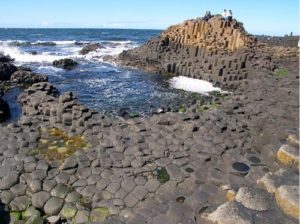by H. Lee, April 1, 2020 in ClimateChangeDispatch
A study has cemented the link between an intense global warming episode 56 million years ago and volcanism in the North Atlantic, with implications for modern climate change.
Roughly 60 million years ago, circulation changes deep within our planet generated a hot current of rock — the Iceland plume — causing it to rise from the heart of Earth’s mantle.
…
…

The Giant’s Causeway in Northern Ireland is a geologic feature consisting of thousands of interlocking basalt columns that formed from volcanic eruptions 60 million years ago.
The Wrong Kind Of Carbon
Although a great deal of North Atlantic volcanism happened close in time to the PETM, scientists were initially skeptical that it could have driven the warming.
Sedimentary layers that formed at the time had the wrong kind of carbon — they were rich in the isotope carbon-12, indicating an organic carbon source rather than a volcanic one.
The leading theory was that fluctuations in Earth’s orbit around the sun melted a type of frozen methane just beneath the seabed called methane clathrates.
Yet scientists found scant evidence that enough clathrates existed in the pre-PETM world, or that they could have melted fast enough to drive the warming.
A possible missing link between the North Atlantic Igneous Province and organic carbon was spotted in 2004 in seismic scans through the seabed off the coast of Norway.
When Henrik Svensen of the University of Oslo and colleagues analyzed recorded echoes from air blasts produced by oil exploration ships, they saw vents leading upward from sills that formed around the time of the PETM.
They reasoned that the vents resulted from hot sills baking organic detritus, which is rich in carbon-12. This would have generated methane and carbon dioxide.
The gases would have erupted through the seabed and ocean and into the atmosphere, driving the PETM. More vents have since been spotted on both sides of the Atlantic, and samples have been drilled from one of them.
Similar vents in Siberia and in South Africa have been linked to global warming in different periods of Earth’s history — the Permian and the Jurassic respectively.
Still, few thought that igneous activity could act fast enough. Geologists thought the sills formed over a few million years, whereas fossilized sediments show it took just a few thousand years to start the PETM.
The Birmingham team has closed that gap. They found that with the Iceland plume, as Jones put it, “you can turn the tap on … in five to ten thousand years.”
Read rest at Quanta Magazine
